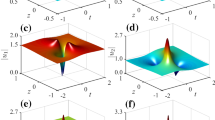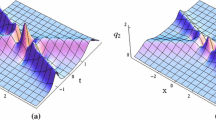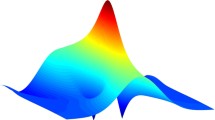Abstract
In this work, the modulation instability and solitonic rogue waves are addressed in the repulsive lattice formed by identical particles with nearest neighbor couplings. We use the multiple scale method to derive the extended nonlinear Schrödinger equation with fourth-order dispersion and cubic–quintic nonlinearity. To calculate the modulation instability growth rate, a linear stability analysis is used. Thereafter, we have demonstrated that both fourth-order dispersion and quintic nonlinearity can change the amplitude of the plane wave and bandwidth of the modulation instability in normal and anomalous dispersion regimes. The dynamics of the solitonic rogue waves have been pointed out to show an increasing amplitude with the variation of the free amplitude parameter of the chain of magnets. Via the numerical simulation, the modulated wave patterns have been exhibited to manifest the development of the modulation instability spectrum in the lattice, and the long-time evolution of the continuous waves has brought new features to show an increasing amplitude of the trains of pulses under the variation of the interaction interatomic parameters. These parameters are revealed to be a suitable tool to manipulate nonlinear objects in nonlinear media where higher-order dispersion competes with nonlinearity.













Similar content being viewed by others
Availability of data and materials
Not applicable.
References
C.A. Li, S.B. Zhang, J. Li, B. Trauzettel, Higher-order Fabry-Pérot interferometer from topological hinge states. Phys. Rev. Lett. 127, 026803 (2021)
J. Li, S. Chockalingam, T. Cohen, Observation of ultraslow shock waves in a tunable magnetic lattice. Phys. Rev. Lett. 127(1), 014302 (2021)
M. Molerón, C. Chong, A.J. Martínez, M.A. Porter, P.G. Kevrekidis, C. Daraio, Nonlinear excitations in magnetic lattices with long-range interactions. J. Phys. 21, 063032 (2019)
A. Mehrem, N. Jiménez, L.J. Salmerón-Contreras, X. García-Andrés, L.M. García-Raffi, R. Picó, V.J. Sánchez-Morcillo, Nonlinear dispersive waves in repulsive lattices. Phys. Rev. E 96, 012208 (2017)
J.B. Sonkeng, F.I. Ndzana, S. Abdoulkary, A. Mohamadou, Modulational instabilities and chaotic-like behaviors in repulsive lattices. Eur. Phys. J. Plus 136(2), 1–11 (2021)
L. Akinyemi, A. Houwe, S. Abbagari, A.M. Wazwaz, H.M. Alshehri, M.S. Osman, Effects of the higher-order dispersion on solitary waves and modulation instability in a monomode fiber. Optik 288, 171202 (2023)
A. Tsurui, Wave modulations in anharmonic lattices. Progr. Theoret. Phys. 48(4), 1196–1203 (1972)
M.Z. Huang, W.Y. Ching, Calculation of optical excitations in cubic semiconductors. I. Electronic structure and linear response. Phys. Rev. B 47, 9449 (1993)
C.B. Tabi, H. Tagwo, T.C. Kofané, Modulational instability in nonlinear saturable media with competing nonlocal nonlinearity. Phys. Rev. E 106, 054201 (2022)
Y.S. Kivshar, M. Peyrard, Modulational instabilities in discrete lattices. Phys. Rev. A 46, 3198 (1992)
F.K. Abdullaev, A. Bouketir, A. Messikh, B.A. Umarov, Modulational instability and discrete breathers in the discrete cubic-quintic nonlinear Schrödinger equation. Phys. D Nonlinear Phenom. 232, 54–61 (2007)
F.G. Mounouna, E. Wamba, A.S.T. Nguetcho, I.A. Bhat, J.M. Bilbault, Modulational stability brought by cubic-quartic interactions of the nearest-neighbor in FK model subjected in a parametrized on-site potential. Commun. Nonlinear Sci. Numer. Simulat. 105, 106088 (2022)
A.S.T. Nguetcho, E. Wamba, Effects of nonlinearity and substrate’s deformability on modulation instability in NKG equation. Communicat. Nonlinear Sci. Numer. Simulat. 50, 271–283 (2017)
A. Houwe, S. Abbagari, Y. Saliou, L. Akinyemi, S.Y. Doka, Nonlinear generation modes in easy-axis anisotropy ferromagnetic spin chains with nearest-neighbor coupling. Eur. Phys. J. Plus 138, 133 (2023)
A. Houwe, S. Abbagari, L. Akinyemi, M. Inc, S.Y. Doka, Wave propagation in discrete cold bosonic atoms zig-zag optical lattice. Eur. Phys. J. Plus 137(9), 1–11 (2022)
T. Tanemura, Y. Ozeki, K. Kikuchi, Modulational instability and parametric amplification induced by loss dispersion in optical fibers. Phys. Rev. Lett. 93, 163902 (2004)
S.G. Murdoch, R. Leonhardt, J.D. Harvey, Polarization modulation instability in weakly birefringent fibers. Opt. Lett. 20, 866 (1995)
S. Abbagari, A. Houwe, L. Akinyemi, S.Y. Doka, Modulation instability and modulated wave patterns in a nonlinear electrical transmission line with the next-nearest-neighbor coupling. Chin. J. Phys. 85, 722–732 (2023)
S. Abbagari, A. Houwe, L. Akinyemi, Y. Saliou, T.B. Bouetou, Modulation instability gain and discrete soliton interaction in gyrotropic molecular chain. Chaos Solitons Fractals 160, 112255 (2022)
S. Wen, Y. Xiang, W. Su, Y. Hu, X. Fu, D. Fan, Role of the anomalous self-steepening effect in modulation instability in negative-index material. Opt. Express 14(4), 1568–1575 (2006)
M. Molerón, A. Leonard, C. Daraio, Solitary waves in a chain of repelling magnets. J. Appl. Phys. 115, 184901 (2014)
V. Nosenko, K. Avinash, J. Goree, B. Liu, Nonlinear interaction of compressional waves in a 2D dusty plasma crystal. Phys. Rev. Lett. 92, 085001 (2004)
X. Wang, B. Yang, Y. Chen, Y. Yang, Higher-order rogue wave solutions of the Kundu-Eckhaus equation. Phys. Scr. 89, 095210–15 (2014)
F. I.I. Ndzana, G. Djelah, A. Mohamadou, Solitonic rogue waves dynamics in a nonlinear electrical transmission line with the next nearest neighbor couplings. Chin. J. Phys. 77, 1927–1945 (2022)
E. Kengne, Nonlinear wave transmission in a two-dimensional nonlinear electric transmission network with dissipative elements. Chaos Solitons Fractals 164, 112637 (2022)
A. Houwe, S. Abbagari, L. Akinyemi, S.Y. Doka, K.T. Crépin, Modulation instability gain and localized waves in the modified Frenkel-Kontorova model with high-order nonlinearities. Chaos Solitons Fractals 173, 113744 (2023)
N. Akhmediev, A. Ankiewicz, M. Taki, Waves that appear from nowhere and disappear without a trace. Phys. Lett. A 373, 675–678 (2009)
K. Dysthe, H.E. Krogstad, P. Müller, Oceanic rogue waves. Annu. Rev. Fluid Mech. 40, 287–310 (2008)
D.R. Solli, C. Ropers, P. Koonath, B. Jalali, Optical rogue waves. Nature 450(7172), 1054–1057 (2007)
Y.S. Kivshar, G. Agrawal, Optical Solitons: From Fibers to Photonic Crystals (Academic Press, Cambridge, 2003)
A.R. Osborne, Nonlinear Ocean Waves (Academic Press, Cambridge, 2009)
C.J. Pethick, H. Smith, Bose-Einstein Condensation in Dilute Gases (Cambridge University Press, Cambridge, 2002)
F.G. Mounouna, E. Wamba, A.S.T. Nguetcho, I.A. Bhat, J.M. Bilbault, Modulational stability brought by cubic-quartic interactions of the nearest-neighbor in FK model subjected in a parametrized on-site potential. Commun. Nonlinear Sci. Numer. Simulat. 105, 106088 (2022)
Funding
No funding available for this project.
Author information
Authors and Affiliations
Contributions
The authors read and approved the final manuscript.
Corresponding authors
Ethics declarations
Conflict of interest
The authors declare that they have no conflict of interest.
Appendix
Appendix
It is essential to understand how Eq. (8) is generated. As a result, to derive Eq. (8), we use the method described in [7, 8, 12, 13]. We express the following equations using Taylor expansion in order 2 for the function \(\psi (x,\tau )\) as follows:
By substituting Eq. (27) into Eq. (4), and collecting terms of order \(e^{i\theta _n},\) we obtain the following equation:
In the upper frequencies, i.e., \(k=\pi \) and \(\omega =\sqrt{1+\Omega _{0}^2},\) considering the order terms only \(\epsilon ^{0}\) and \(\epsilon ^{2},\) we obtain
Rights and permissions
Springer Nature or its licensor (e.g. a society or other partner) holds exclusive rights to this article under a publishing agreement with the author(s) or other rightsholder(s); author self-archiving of the accepted manuscript version of this article is solely governed by the terms of such publishing agreement and applicable law.
About this article
Cite this article
Houwe, A., Abbagari, S., Akinyemi, L. et al. Modulation instability spectrum and rogue waves of the repulsive lattices. Eur. Phys. J. Plus 139, 177 (2024). https://doi.org/10.1140/epjp/s13360-024-04961-2
Received:
Accepted:
Published:
DOI: https://doi.org/10.1140/epjp/s13360-024-04961-2




